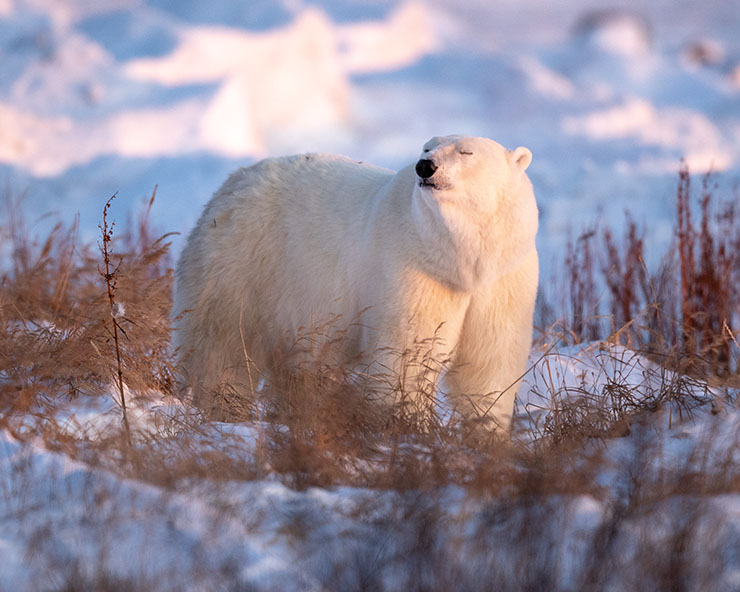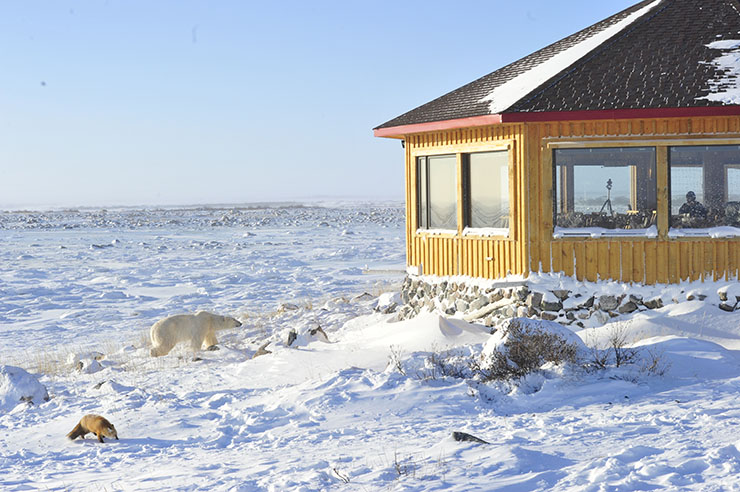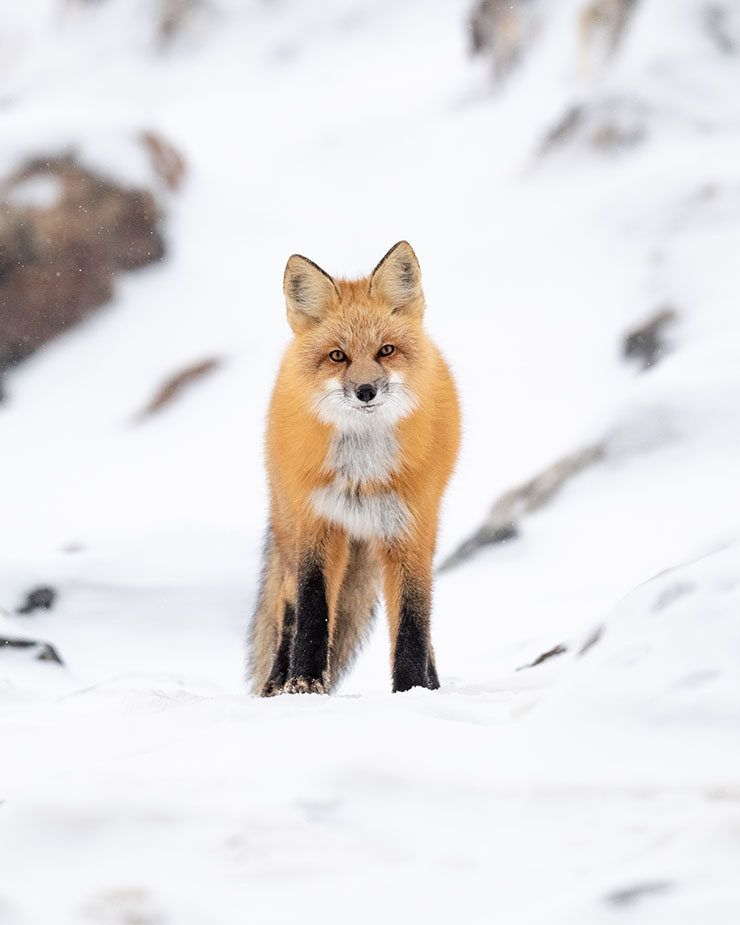Up close with polar bears

By Suzanne Morphet
e’re casually watching a pair of frisky Arctic foxes playing on the shoreline of Hudson Bay when our guide arrives with welcome news.
A polar bear has been spotted. It’s half a kilometre away and heading straight for us.
It’s hard to pick a white bear out of a white background—especially when your heart is hammering—but now I see him, striding confidently towards us over the tidal flat on big, furry feet. The foxes scatter from his path as we take up positions along the big picture windows of our lodge, cameras ready.
For this bear—our first—I’m glad we’re inside. But for the next three days we’ll go on long walks on the tundra, looking for more of the largest land carnivores on the planet.
I first heard about polar bear safaris at Seal River Heritage Lodge from a friend who was visiting from Belgium. Aline was on a month-long tour of some of Canada’s most magnificent places and when she arrived in British Columbia—her last stop—all she could talk about was walking with polar bears in Manitoba. And these were not bears behind bars in the Winnipeg zoo, but bears in the wild. At an eco-lodge on the shore of Hudson Bay. Off the grid and perhaps—I wondered—for people a little off their rockers.
But crazy as it seemed, after hearing about Aline’s remarkable experience, I knew I had to go.

It’s a 30-minute flight from Churchill to the private airstrip at Seal River Heritage Lodge. After settling into our comfortable rooms and lunching in the sunny dining room overlooking Hudson Bay, we gather in the lounge to learn more about what’s in store in the days ahead.
“We won’t walk straight up to a bear,” says Andy McPherson, the lead guide, explaining that we’ll trek in tight single file and approach a bear slowly, “showing him how big we are.”
“We want to be one visual presence,” he adds.
In 26 years of offering walking safaris, guides with Churchill Wild—the company that owns this lodge and three others on this coast—have never had to shoot a bear. Instead, if one comes too close, they’ll talk loudly to it, “like I’m talking to a dog,” says Andy, or throw stones at it. “Bangers” and “screamers,” noisy deterrents that are commonly used in the town of Churchill, are rarely used here.
The next morning the temperature has plummeted to minus 10 C and we gather outside dressed in puffy parkas and big boots. (I leave behind my favourite sealskin toque after learning that polar bears have a wicked sense of smell and seals are their favourite food.)
We number 15—seven Americans, three Aussies, a couple Israelis, two Brits and me—the lone Canadian. Interestingly, two women left their husbands at home and are here with their adult sons.
Crunching through the snow, we follow Andy, while two other guides bring up the rear. All three carry rifles while the rest of us are armed only with cameras and a taste for adventure.
It’s not by chance that Churchill Wild picked this stretch of Hudson Bay coastline for eco-tourism. It’s where the boreal forest meets the Arctic tundra and it’s rich with wildlife. Not only does it boast the largest concentration of polar bears in the world, but grizzlies and black bears are here too, along with moose and caribou. In the summer, thousands of beluga whales congregate in the Seal River estuary. In early November, when we arrive, polar bears are patiently waiting for ice to form on the bay so they can go offshore to hunt seals.
Our first few walks on the tundra are bear-free. But there’s much else to savour: the dramatic black and white world of boulders and snow; or the hazy blue light on the bay one morning, illuminating the ice that formed overnight. Ptarmigans and Arctic hares hiding in plain sight simply by standing still. Eyelashes trimmed with frost after an exhilarating walk.
In fact, there’s so much to observe that one morning when Andy tells us to keep an eye on the grassy ridges near the shoreline, I ask what we’re looking for.
“Polar bears,” he replies.
Oh, right.
Of course, we enjoy our time inside the lodge as well, especially appetizers and wine in front of a roaring fire each evening. Meals are at family-sized tables with big helpings of comfort food, including wildly harvested meat and fish. After dinner, we’re treated to lectures about all things polar bear.
Did you know that female bears experience something called “delayed implantation?” They mate in the spring, but fertilized eggs aren’t implanted until the fall, and only if the bear is healthy enough to support cubs through a long winter, much of it without food.
Andy believes the bear population is doing well, despite climate change. “They’ve lived through warmer periods and survived,” he says. “They’re exceptionally intelligent animals.”
On our final morning walk, we spot a bear and her cub bedded down in a nest of seaweed. At about 70 metres away, Andy motions us to stop and watch. When the bears finish napping, they completely ignore us. They stretch, they yawn and they scratch their chins in what appears to be boredom, the same way a person would.
“Researchers will say you’re anthropomorphizing,” says Andy, who has been guiding here for the past 14 years, “but spending the time we do with them, you can’t help but see it.”

On our last night, I’m watching foxes playing outside the window when someone yells “bear!”
A mother and two cubs are approaching. When they get as close as they can (an electric fence is between them and the window) they peer up at us, as harmless-looking as teddy bears, and just as adorable. Then, off they walk into the snowy night, pausing once to look back, as if to say, “thanks for visiting.” Good-bye, bears. We wish you all the best.
For dates and rates see churchillwild.com

 Secrets and lives — AND THE 7 SINS with Kristina Matisic
Secrets and lives — AND THE 7 SINS with Kristina Matisic